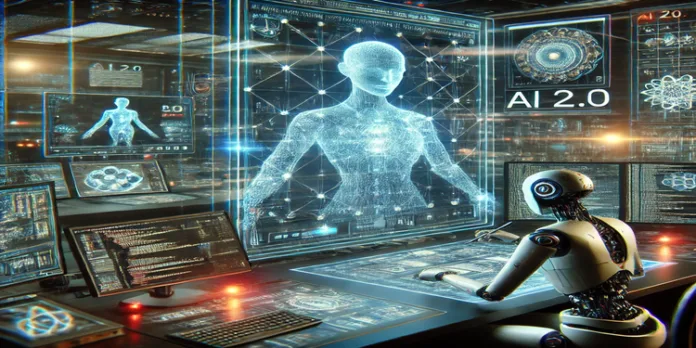Artificial Intelligence has been a transformative force for more than a decade, but what we’re witnessing in 2025 goes beyond automation and data analysis. At the heart of this transformation is the rise of AI 2.0—an era where machines are no longer just learning from data, but actively generating new worlds of possibility. The tech world is in the midst of a seismic shift with the advent of AI 2.0, powered by generative models that are not just analyzing data—they’re creating it. Generative AI has transcended from niche applications to becoming a core driver of innovation across industries, from software development and design to healthcare and entertainment.
So, what is fueling this rapid evolution, and how are these generative models redefining how technology is developed, delivered, and consumed? Let’s explore the game-changing impact of AI 2.0.
What is AI 2.0 and How is it Different?
AI 2.0 represents the next wave of artificial intelligence where models no longer just make predictions based on historical data but generate new content, solutions, and ideas autonomously. Traditional AI systems, often termed AI 1.0, were excellent at classification tasks, pattern recognition, and automation of repetitive processes. However, AI 2.0—driven by powerful generative models like large language models (LLMs), diffusion models, and transformer-based architectures—has introduced creativity into the equation.
These models can now:
- Generate human-like text
- Compose music
- Create art and graphics
- Simulate human conversations
- Write and debug code
- Design prototypes for products and systems
The Rise of Generative Models
Generative AI models, such as transformers, GANs (Generative Adversarial Networks), and diffusion models, are designed to learn patterns from massive datasets and use that knowledge to create something entirely new. What started with models capable of generating realistic faces or short-form content has now evolved into systems that can autonomously write articles, develop software, and even create 3D environments.
Large Language Models (LLMs) like GPT variants and multimodal AI systems are revolutionizing industries by integrating natural language understanding, image generation, video creation, and more. The versatility and accuracy of these models are enabling them to handle tasks once thought to be exclusive to human intelligence.
Key Industries Being Transformed by AI 2.0
1. Software Development
Generative models are automating parts of the software development lifecycle. From code completion and bug fixing to writing entire scripts and testing frameworks, AI is significantly reducing time-to-market for software products. Tools powered by AI 2.0 can assist developers in creating cleaner, optimized, and more secure code, enabling faster innovation.
2. Creative Industries
Graphic designers, video editors, musicians, and writers are collaborating with AI like never before. AI-generated visuals, music scores, and even cinematic scripts are making their way into mainstream media and advertising. While AI does not replace human creativity, it acts as a powerful co-creator, boosting productivity and ideation.
3. Healthcare
AI 2.0 is helping healthcare providers by generating patient summaries, drafting clinical documentation, and even simulating drug discovery processes. Generative AI models can predict protein folding, accelerate vaccine design, and create patient-specific treatment recommendations by analyzing large medical datasets.
4. Customer Support and Business Operations
AI-powered chatbots and virtual assistants have evolved from scripted Q&A bots into conversational agents that can handle complex queries, understand customer sentiment, and offer tailored solutions. In business operations, AI-generated reports and analyses are becoming critical to faster decision-making.
5. Entertainment and Gaming
Generative AI is now crafting hyper-realistic characters, dynamic storylines, and immersive virtual environments. Game developers are leveraging AI to procedurally generate maps, textures, and narratives, enhancing user experience while cutting production time.
The Driving Forces Behind AI 2.0
1. Data Availability
The explosion of data from the internet, IoT devices, and enterprise systems has given AI models an unprecedented volume of information to learn from. AI 2.0 thrives on large datasets, making today’s data-rich environment ideal for its growth.
2. Computing Power
The democratization of high-performance computing (HPC) and cloud-based GPUs/TPUs has accelerated the training and deployment of massive AI models. The processing power required to run advanced generative models is now more accessible than ever.
3. Open-Source AI Communities
The global AI community is sharing research, tools, and models at a rapid pace. Open-source frameworks and pre-trained models have reduced the barrier to entry for businesses and researchers, fueling the widespread adoption of AI 2.0 technologies.
Challenges and Ethical Considerations
Despite its vast potential, AI 2.0 presents several challenges:
- Bias and Fairness: Generative models may inherit biases from their training data, leading to skewed or unethical outputs.
- Intellectual Property Concerns: As AI generates original content, questions about ownership and copyright are gaining attention.
- Misinformation and Deepfakes: AI’s ability to create hyper-realistic media raises concerns about the spread of false information and digital manipulation.
Businesses must ensure responsible AI use by prioritizing transparency, ethical guidelines, and human oversight.
The Future of Generative AI
Looking ahead, AI 2.0 is expected to evolve even further into AI 3.0, where models will seamlessly integrate multi-modal inputs (text, video, audio, 3D models) and autonomously collaborate across diverse tasks. We are also likely to see more “specialist” AI models fine-tuned for specific industries or applications.
Moreover, generative AI will play a major role in powering AI-driven automation platforms, revolutionizing industries such as legal services, supply chain logistics, and even scientific research.
Final Thoughts
AI 2.0 is not just another phase in the evolution of artificial intelligence—it is redefining what’s possible in technology. By merging creativity with computation, generative models are breaking the barriers between human ingenuity and machine intelligence. Whether you’re a developer, business leader, or creative professional, understanding and leveraging AI 2.0 will be critical to thriving in the tech-driven economy of the future.
The rise of AI 2.0 is not just about machines generating content; it’s about reshaping how we innovate, collaborate, and solve real-world problems in ways we could only imagine a few years ago.
